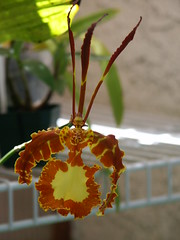Orchid care is more like an art than a science. Of course, you can easily get general directions on how to care for a particular orchid genus. For example, Cattleya needs medium bright light, or Miltonia likes intermediate temperature. However, there are many “fudge” factors to create the perfect condition for your very own growing environment. All elements need to complement one other for your orchid to thrive. You will also need to observe your plants to gauge their happiness with the current treatments.
Routine Orchid Care
Six elements are essential to your orchid care program. These elements are the ones that you provide your orchids on a daily/weekly/monthly basis—water, temperature, light, air movement, humidity and fertilizer. They all work together to ensure the health of your orchids.
1. Water
To water or not to water, that’s the question. Orchid casualties, most of the time, are caused by over-watering. So how much should you water? It will depend on your humidity, air movement and temperature. Read more about providing the right amount of water to your orchid.
2. Temperature
Finding out what type of orchids you have will give you a pretty good idea of what temperature it needs. Generally speaking, the temperature ranges are cool, intermediate and warm. Read about what’s these temperature ranges mean.
3. Light
The leaves an orchid have can tell you a lot about the light level it needs. To make your life a bit easier, orchid growers categorize the light levels as low, medium and high. Read about giving your orchids the right level of light.
4. Air movement
If I put you in a glass jar with no wind, I bet you wouldn’t be very happy (or healthy, or able to stretch out). Orchids also need air movement to be healthy. The more humid a place is, the more essential air movement becomes. Read about why air movement is important.
5. Humidity
Humidity is just water in the air. If you read my other pages on this site, you would know that most orchids come from the Tropics, where the air is very humid. Read about why humidity is extremely important to the success of your orchid care program.
6. Fertilize
Many people swear by the “weekly weakly” routine of fertilizing their orchid plants. But some orchids are more fertilizer-hungry than others and sometimes it is important to hold off giving any plant food to your orchids. Read about when and how much to fertilize.
Long Term Orchid Care
On the other hands, your orchid care routine should also include some less frequent but equally important tasks. These are usually the on-demand tasks that happen once a year or once every several years.
1. Repotting
As kids out-grow their clothes, orchids also out-grow their pots. Proper orchid care needs to include periodic repotting. Your choice of potting materials is also critical the success of growing and blooming your plants.Read about how and when to repot as well as the typical potting materials.
2. Propagating
After you have your plants for a while, you may want to make more orchids out of the original plant. You can produce more orchids by breeding, diving, planting keikis or planting cut stems. Read about how to breed and divide as well as plant keikis or cut stems.
3. Spike support
Congratulations! You see a spike coming out, which at least means you didn’t kill it! What should you do now to make sure the flowers come out beautifully? You don’t want to mess it up in this critical moment! Read about how to support your orchid spikes.
4. Sheath
What the heck is a sheath? They are kind of like little envelops that protect the flower buds from the harsh elements. They usually only appear on the Cattleya alliance orchids. Read about what you should do with orchid sheaths.
Happy growing!


